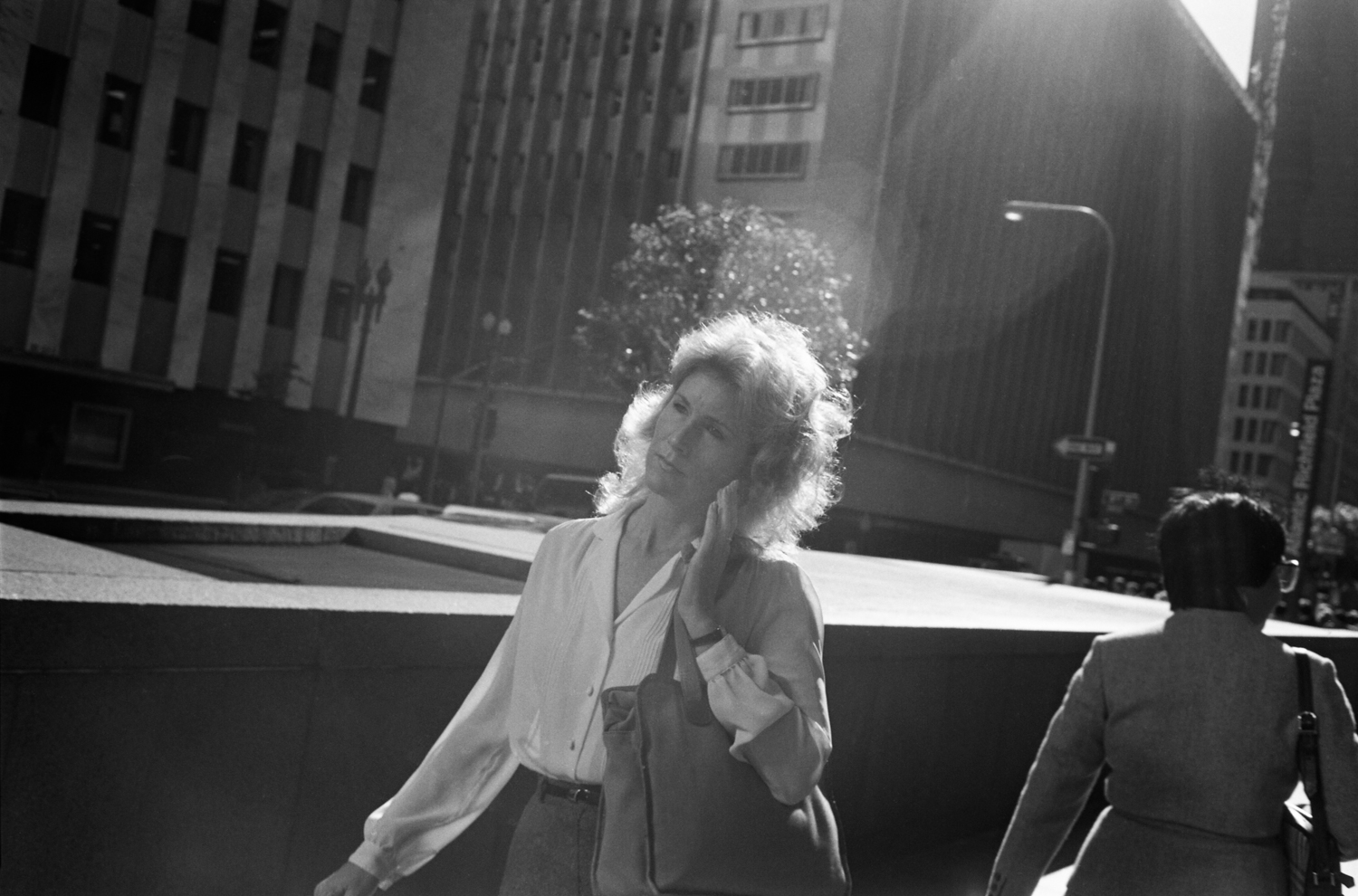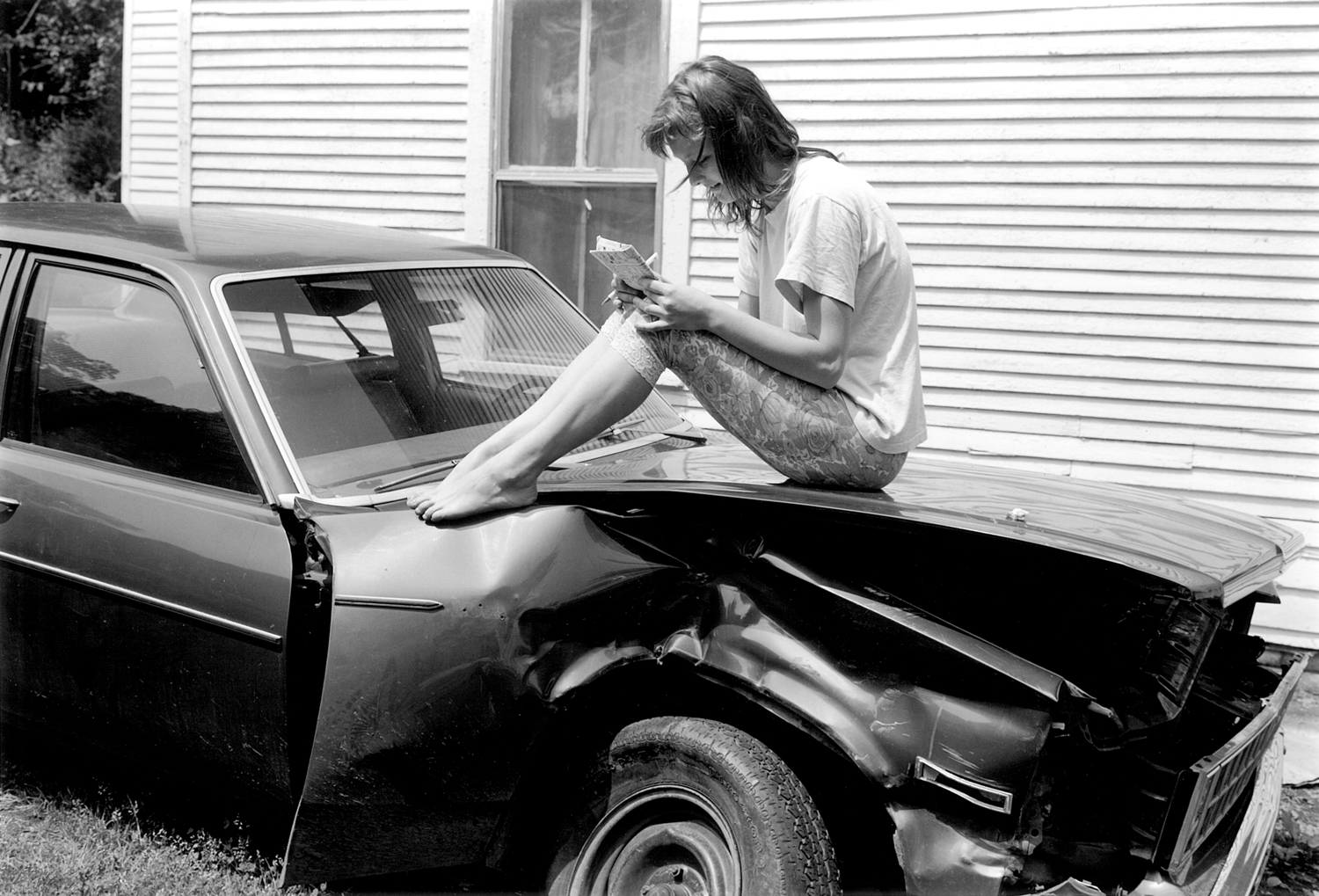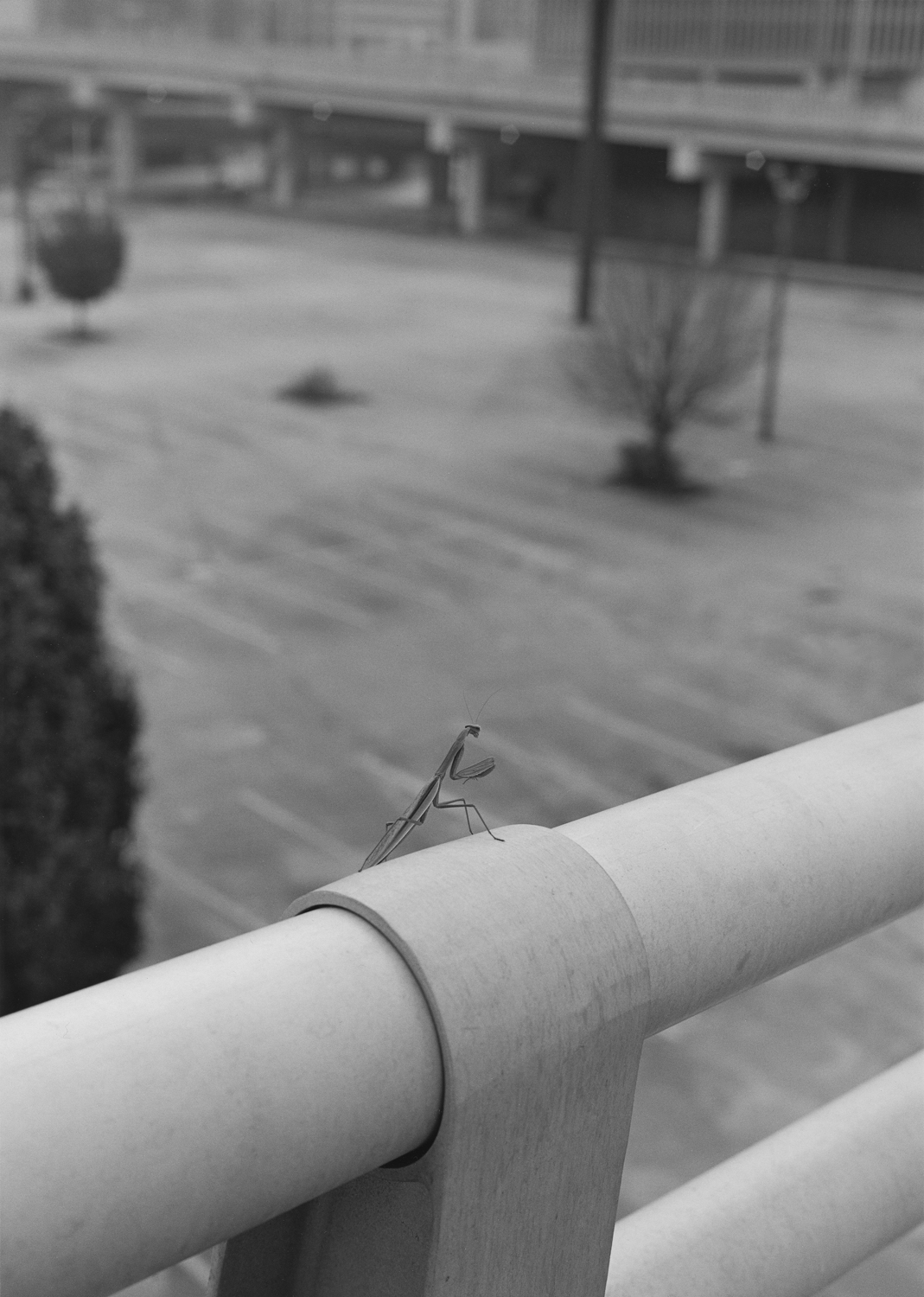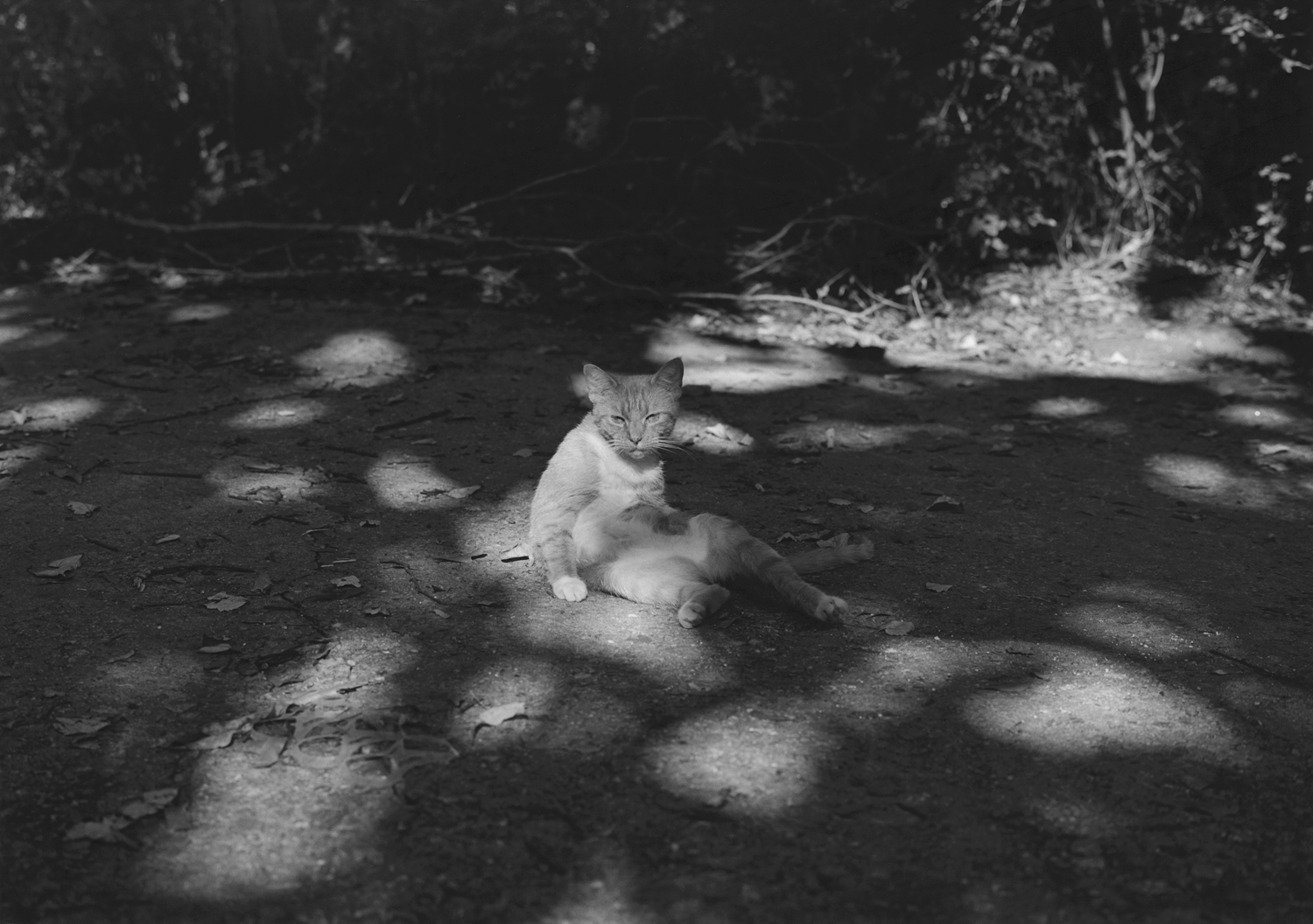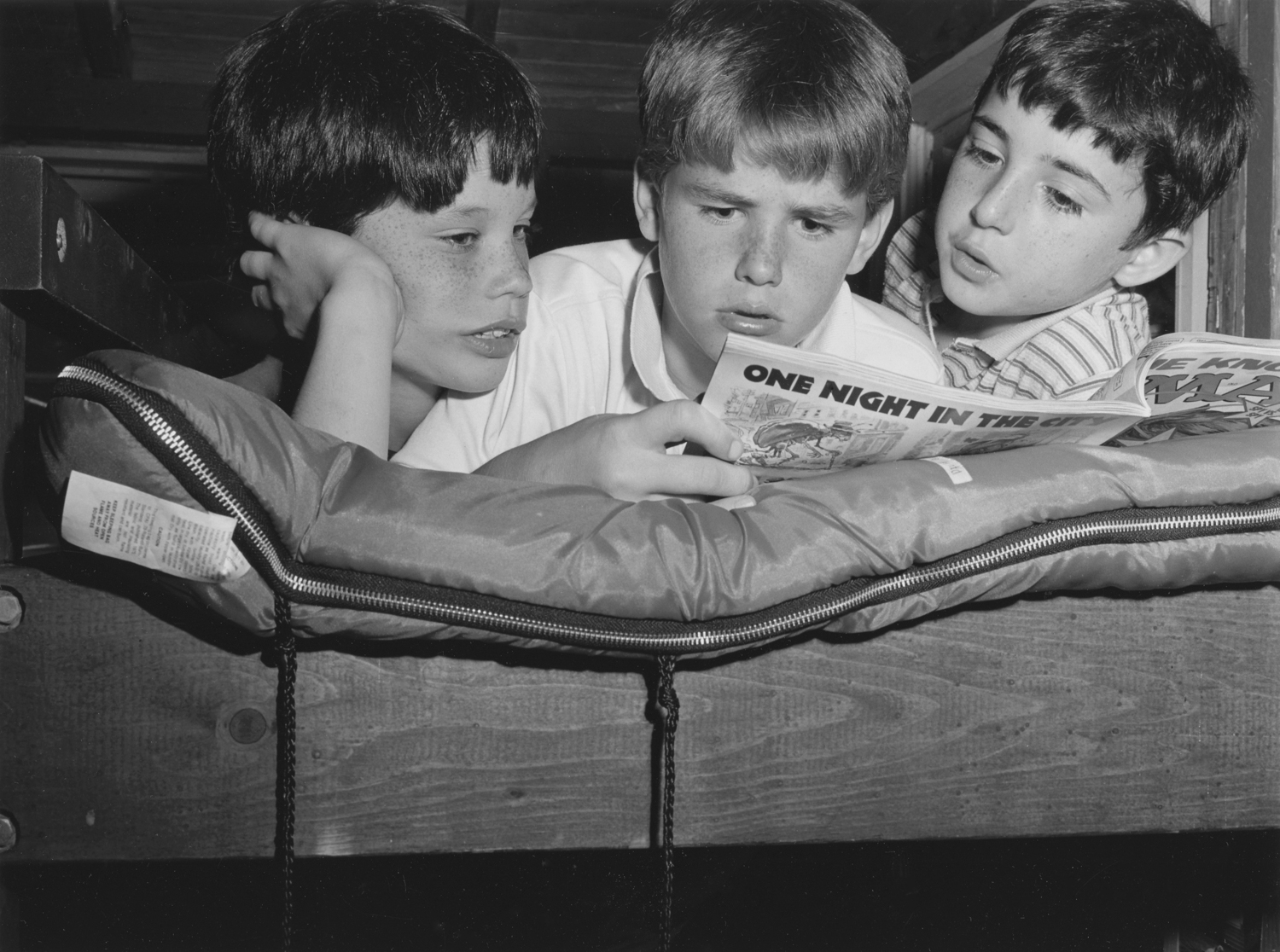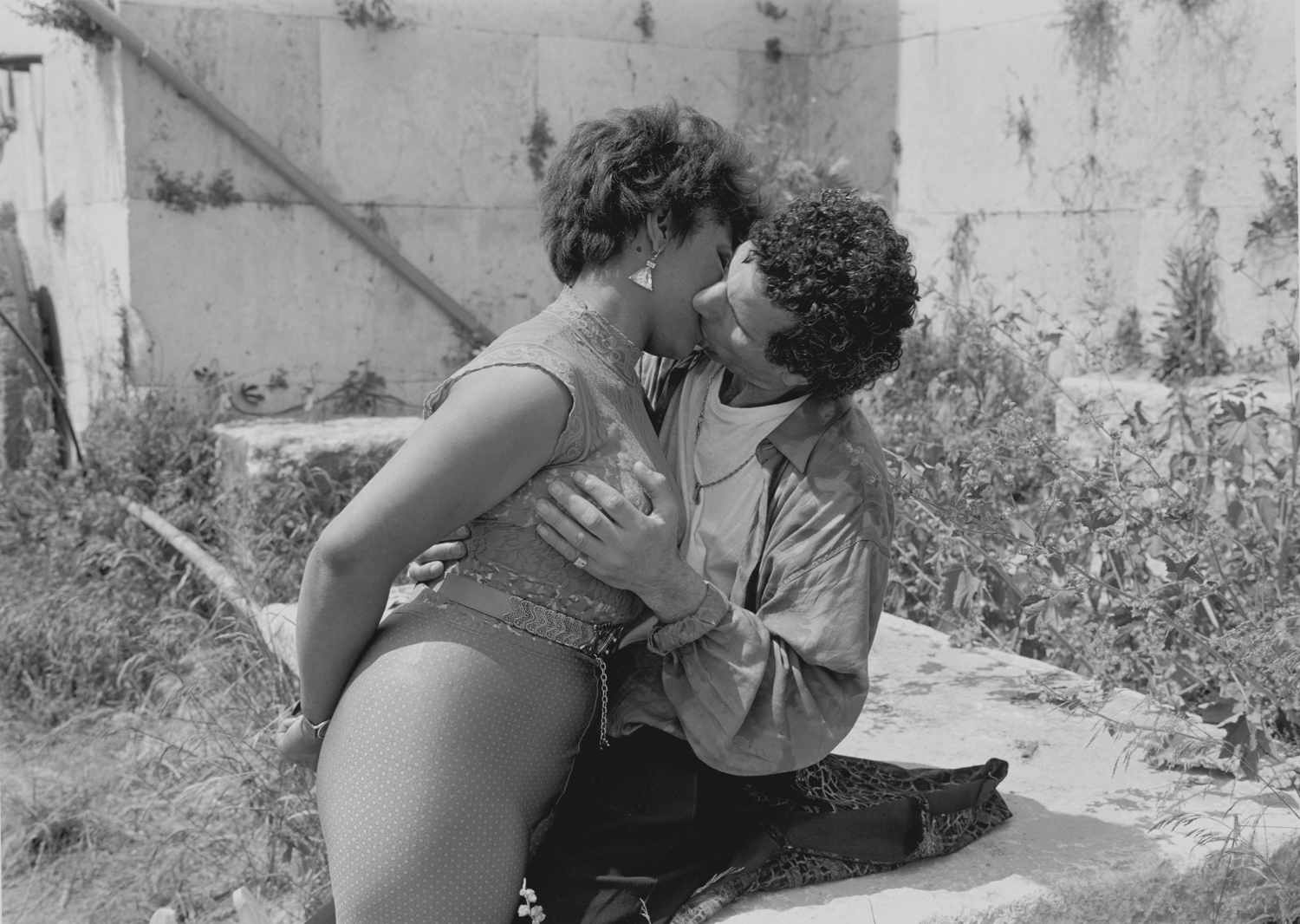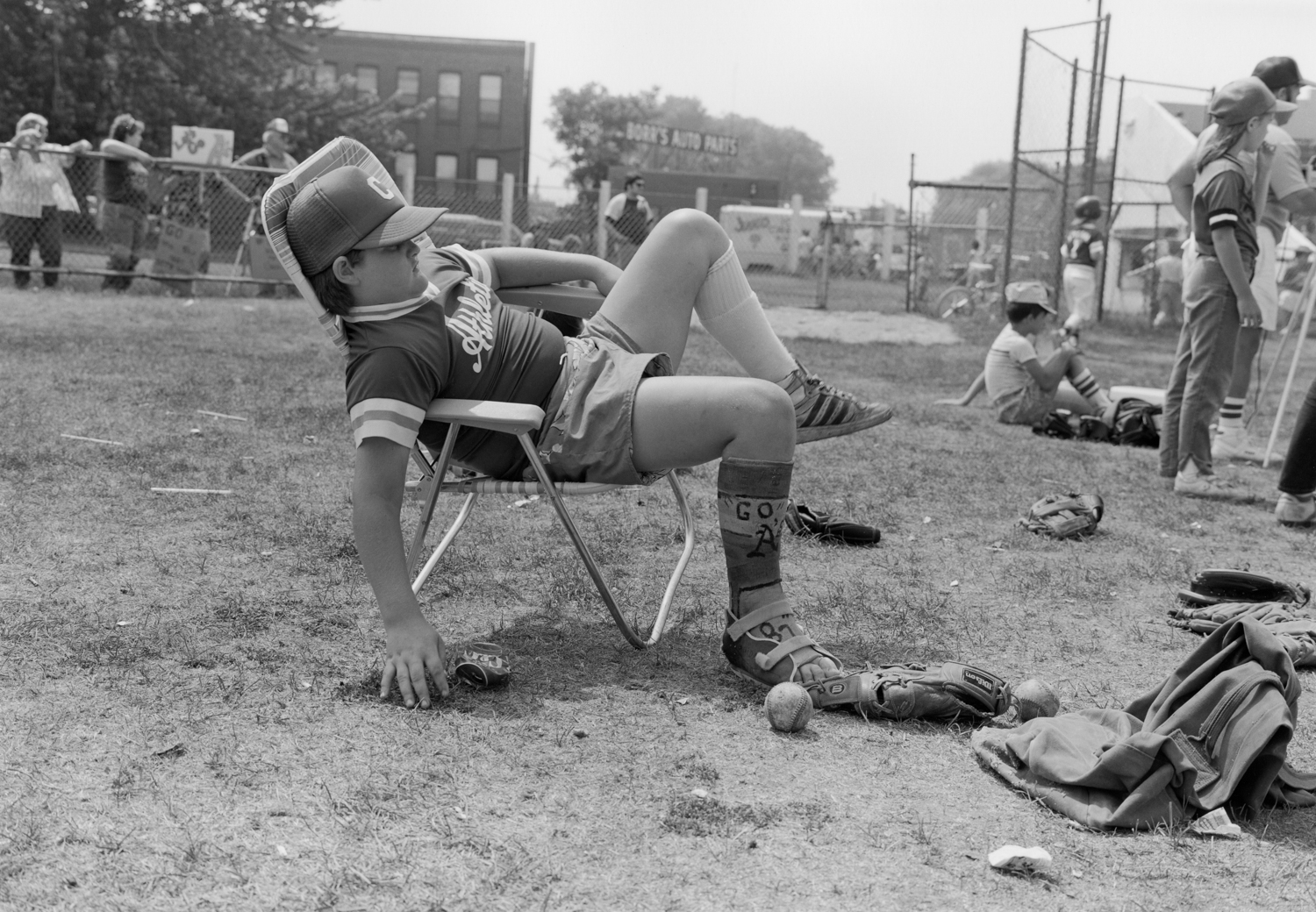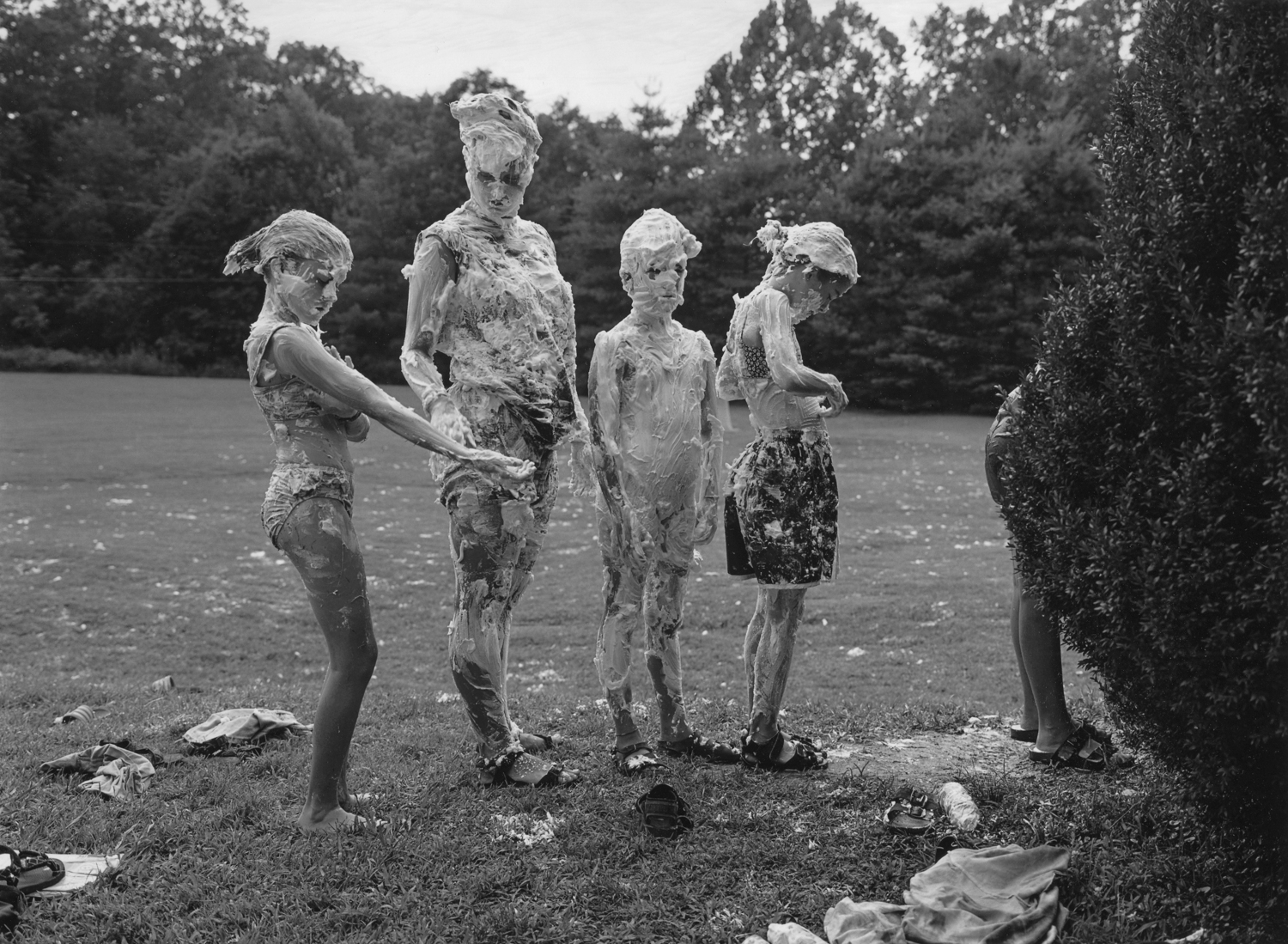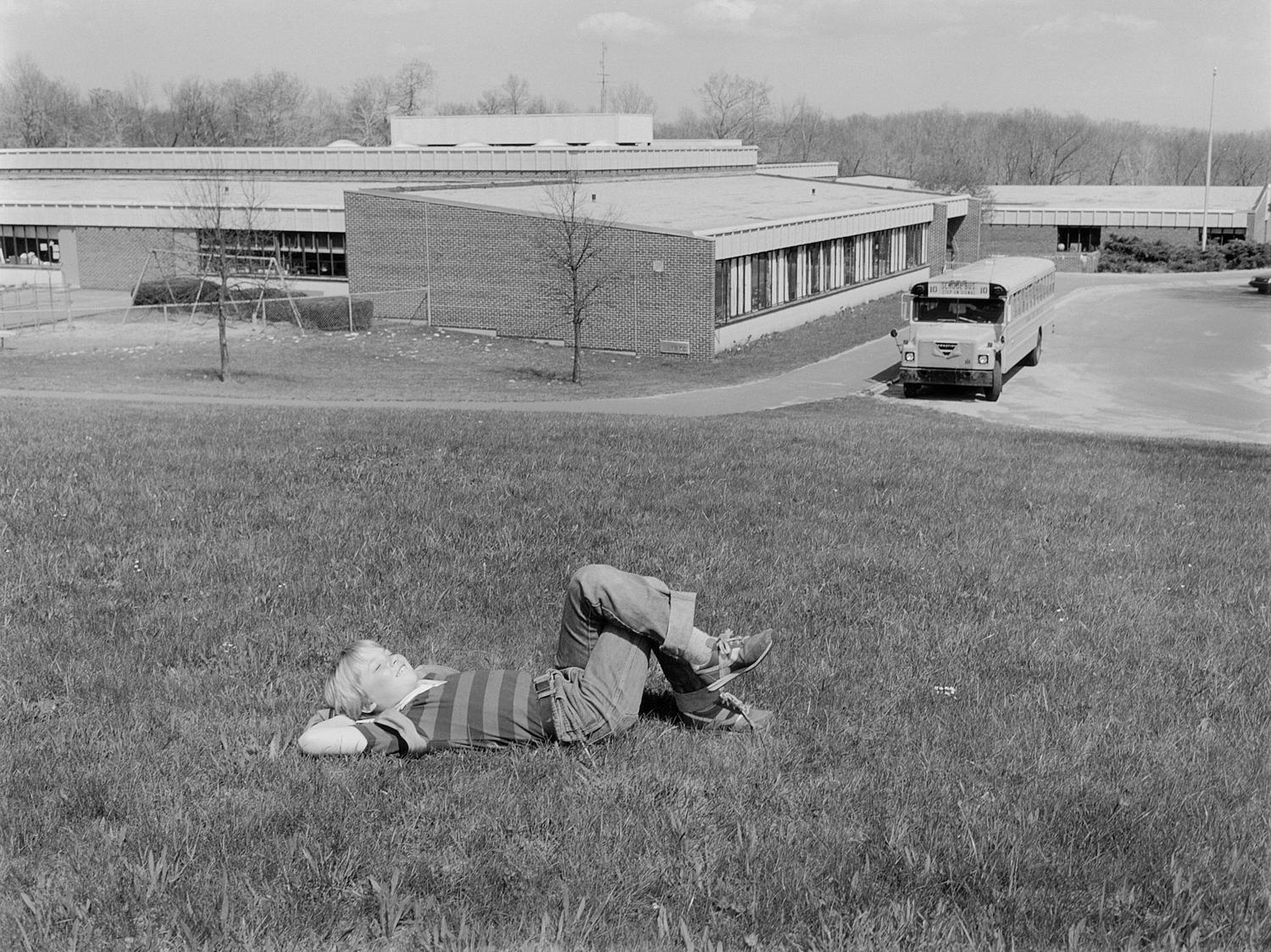For more information please go here
South- Yancey Richardson Gallery, April 6 - May 13, 2017
Angel City West at Charles A. Hartman Fine Art- February 16- April 1, 2017
Opening Reception Thursday March 2
More info here
Los Angeles, 1984
Mark Steinmetz discusses a photo from the early work of Diane Arbus.
Originally appeared in Time Lightbox
Looking through the early photographs of Diane Arbus, I am struck by the ones where Arbus goes unnoticed by her subjects. In Couple Arguing, Coney Island, NY, 1960, something is really happening. The man takes up the center of the frame while the woman floats a little behind and clings to him tightly. Without much by way of legs or arms, she could be an annoying apparition. Her mouth is wide-open in mid-yap; his is tightly shut. His face is turned away from her verbal onslaught as he tries to tune her out. His right arm is positioned as if carrying a shield (this gladiator has a cigarette instead of a sword), and his eyes seek an escape somewhere off in the distance and in the future.
Mark picks for best photo book of 2016 for Time Lightbox
Mark Steinmetz selects Horse by Jitka Hanzlova as a best photo book of 2016 for Time Lightbox
Angel City West at Micamera Milan part of the Photo Vogue Festival
A selection of work is currently on display at Micamera starting November 18th.
Check out the recent press: Vogue Italia & Il Sole 24 ORE
Latest News
Latest News From the Steinmetz Studio
Image from True Photo Journal
- 15 Miles to K-ville signed books are now available from photo-eye Bookstore
- Milwaukee Art Museum is showing some Mark's photos in their permanent collection in their upcoming exhibition The Lives of Others: Portraits from the Photography Collection
- A large selection of Mark Steinmetz's color photographs will be published this month in the upcoming issue of True Photo Journal (London).
Paris Photo Book Signings
MERCREDI 9.11.2016
PAYSAGES AMERICAINS : LA PRATIQUE EDITORIALE DE MARK STEINMETZ 17h00-19h00 Signature des livres et discussion avec Mark Steinmetz. Taking place at Le Monte en L'air at 71, rue de Ménilmontant / 2, rue de la Mare, 75020 Paris
Saturday 12th November
4pm
Paris Photo, Grand Palais, 3 Avenue du Général Eisenhower, 75008 Paris, France
Yancey Richardson, Main Sector
Saturday 12th November
6:30-7:30 Yvon Lambert Gallery and Bookshop, 108 rue Vieille du Temple 75003 Paris
We hope to see you there!
Edge to Edge- MOCA GA
Sep 3, 2016 - Dec 3, 2016
11am - 5pm
Curated by Chip Simone
Exhibition supported by Massey Charitable Trust
This fall The Museum of Contemporary Art of Georgia will exhibit “Edge to Edge”, the first ever state-wide survey of contemporary Georgia photography. The work that has been selected for “Edge to Edge” was chosen for its visual strength, expressive sophistication, and technical artistry. As such the exhibition will serve as a testament to the power of photography itself.
Photography has taken a prominent place in the artistic culture of the contemporary South. Once limited to the traditional themes of the rural and historic south; of rustic barns and rusted trucks; of simple living and country ways, the photographs in this exhibition are modern and reflect a more diverse and complicated world. The pictures were made between the final days of the 20th century and the birth of the 21st. They mirror modern concerns and coincide with the transition from traditional wet process photography to the technical wonders of the digital age. The photographs reveal a more diverse, vibrant and unsettled south which is part of a new demographic that finds most southerners living in urban and suburban centers. The work in this exhibit will reflect many of the changes that are redefining the modern south.
The works by Georgia’s photographers span an eccentric range from familiar and comfortable themes to poetic and provocative evocations, to images that are disquieting and disturbing. These pictures will challenge the viewer who is expecting southern stereotypes with mysterious narratives, poetic revelations, and complex abstractions. The exhibition will present a richly diverse array of the many varied ways contemporary photography is being used artistically and expressively by photographers from across our state, corner to corner and edge to edge.
Edge to Edge is being dedicated to Georgia born photographer Paul Kwilecki (1928-2009), who has been described as “the greatest documentary photographer you’ve never heard of”. Kwilecki was born in the small southwestern town of Bainbridge, Georgia and ran his family’s hardware store for decades. A self-taught photographer, Kwilecki passionately documented life in Decatur County Georgia for more than 40 years. Over time he became a masterful printmaker with an elegant eye. He never photographed elsewhere. Kwilecki eventually received a coveted Guggenheim Fellowship for his work. His photographs are archived at Duke University’s Center for Documentary Studies. We honor Paul for his dedication and commitment to photography. And we honor him because he is one of our own.
Southern Accent- Nasher Museum of Art at Duke University
Southern Accent: Seeking the American South in Contemporary Art.
SEPTEMBER 1, 2016 – JANUARY 8. 2017
Opening Reception August 31 7-10pm
Southern Accent: Seeking the American South in Contemporary Art questions and explores the complex and contested space of the American South. One needs to look no further than literature, cuisine and music to see evidence of the South’s profound influence on American culture, and consequently much of the world. This unprecedented exhibition addresses and complicates the many realities, fantasies and myths that have long captured the public’s imagination about the American South. Presenting a wide range of perspectives, from both within and outside of the region, the exhibition creates a composite portrait of southern identity through the work of 60 artists. The art reflects upon and pulls apart the dynamic nature of the South’s social, political and cultural landscape.
“Southern Accent is an extensive exploration of southern identity through contemporary art,” said Trevor Schoonmaker, Chief Curator and Patsy R. and Raymond D. Nasher Curator of Contemporary Art, and co-curator of the exhibition. “The exhibition has been four years in the making, but the timing of Southern Accent is especially meaningful now – in the wake of Charleston, Orlando, Baton Rouge and countless other tragedies, and given the tense social and racial climate during this presidential election year. We’re an art museum, so exhibitions are our platform for starting conversations. I hope Southern Accent can create a space to reimagine the South in new ways and reframe the way we think about the South in contemporary art. At its best, art can help give shape to cultural and social change, promote needed discourse and even help build community.”
William Faulkner once suggested that the South is not so much a “geographical place” as an “emotional idea.” Southern Accent looks at the South as an open-ended question to be explored and expanded. The exhibition encompasses a broad spectrum of media and approaches, demonstrating that southernness is more of a shared sensibility than a consistent culture. The exhibition includes work dating back to the 1950s, but primarily focuses on art produced within the past 30 years. The exhibition also includes a curated music library since no region in the United States has contributed more to American music than the South. This music chronology that speaks to southern life provides an invaluable counterpoint to the artwork in the exhibition.
This exhibition is co-organized by Trevor Schoonmaker, Chief Curator and Patsy R. and Raymond D. Nasher Curator of Contemporary Art at the Nasher Museum of Art at Duke University, and Miranda Lash, Curator of Contemporary Art at the Speed Art Museum in Louisville, Kentucky.
Southern Accent will travel to the Speed Art Museum, where it will be on view April 29 – August 20, 2017.
Face It- Bowling Green State University Gallery
AUGUST 30 – OCTOBER 6
Reception September 19
An expanded definition of photographic portraiture is explored in this exhibition of works by 27 renowned artists curated by Lynn Whitney, Andrew Hershberger & Jacqueline Nathan. It will be shown at Slocumb Gallery and the Reece Museum at East Tennessee State University in October. A catalogue with an introduction by Andrew Hershberger will accompany the exhibition. Dorothy Uber Bryan Gallery.
Lux: The Radiant Sea at Yancey Richardson Gallery
Mark Steinmetz, Carey, Farmington, Georgia, 1996
July 14- August 20, 2015
Tuesday - Saturday 10am - 6pm
Yancey Richardson Gallery at 25 West 22nd Street
New York NY 10011.
Olivo Barbieri, Mary Ellen Bartley, Christopher Bucklow, Linda Connor, Tim Davis, Mitch Epstein, Roe Ethridge, Lee Friedlander, Bryan Graf, Jitka Hanzlová, CJ Heyliger, Matthew Jensen, Kenneth Josephson, Laura Letinsky, Ray Metzker, Orit Raff, Rinko Kawauchi, Tokihiro Sato, Lynn Saville, Mark Steinmetz, Yosuke Takeda, Wolfgang Tillmans, James Welling
For more information please visit Yancey Richardson Gallery
The Teen Years- Joseph Bellows Gallery
The Teen Years
July 9 - August 26, 2016
Upcoming Exhibition
The Teen Years
July 9th – August 26th, 2016
Opening Reception: July 9th from 6-8pm.
Joseph Bellows Gallery is pleased to announce its upcoming exhibition, The Teen Years. This group exhibition will open on July 9th and continue through August 26th, 2016. An opening reception will be held on Saturday, July 9th, from 6-8 pm.
The Teen Years will feature a selection of both vintage and contemporary photographs that address the physical, social, and emotional aspects of adolescence, and the formation of identity. The photographs included in the exhibition present a collective portrait of youth: its awkwardness, innocence, fury, elation, beauty and trepidation.
Photographs by Joseph Sterling, Edward Sturr, Enrico Natali, Elaine Mayes, Bevan Davies, Nacio Jan Brown, Melissa Shook, Harry Ibach, Duncan McCosker, Christine Osinski, Joan Albert, Sage Sohier, Mark Steinmetz, John Myers, Andrea Modica, Bill Yates, Roger Vail and others will be included.
To request further information or high resolution images please contact Joseph Bellows Gallery at info@josephbellows.com. Established in 1998, Joseph Bellows Gallery features rotating exhibitions of both historic and contemporary photography, with a special interest in American work from the 20th Century. More information can be found at www.josephbellows.com
For more information please visit the Joseph Bellows Gallery
Snapshot: ‘The Teen Years’
Article originally appeared in Financial Times
©Mark Steinmetz, Jessica, Athens, GA, (1997)
In 1983, with a vague idea about working in film, Mark Steinmetz dropped out of Yale School of Art and headed to California. Poor and directionless, he was inspired by a brief friendship with the LA-based black-and-white street photographer Garry Winogrand. His work now features in the collection of the Metropolitan Museum of Art.
Like his mentor, Steinmetz’s monochrome photographs communicate sincerity, closeness and a sense of mystery. “Staged work often seems fairly lifeless,” he says. “There’s little surprise to it — it lacks that freshness, that rawness that comes from discovering something that’s out there in life.”
Travelling the nation, Steinmetz sought to capture the spirit of American adolescence. His work now forms part of the Joseph Bellows exhibition, The Teen Years; a collective portrait of the beauty and awkwardness, the sound and fury of youth.
‘The Teen Years’, Joseph Bellows Gallery, San Diego, California, until August 26; josephbellows.com
©Mark Steinmetz, Highway 441, Georgia-North Carolina State Line, (1997)
©Christine Osinski, Two Girls with Big Wheels, (1983-84)
©Linda Brooks, David in his room, (1981)
©Joan Albert, Martin, (July 1980)
©Elaine Mayes, Rodney, 19, Haight Ashbury, (1968)
©John Myers, Juliette, (1979)
©Andrea Modica, Untitled, Modena, Italy, (2010)
©Edward Sturr, Coney Island, (1963)
The Earth’s Beating Heart: An Interview with Mark Steinmetz by Landscape Stories
Read the full interview HERE
Still Available at a good price: Paris in my time
Pick up your copy of Paris in My Time from Nazraeli UK.
Mark Steinmetz, Angel City West
By Loring Knoblauch | Originally appears in Collector Daily
JTF (just the facts): Published in 2015 by Nazraeli Press (here), as part of the NZ Library Set Two. Hardcover, slipcased, 64 pages, with 58 black and white reproductions. Includes a short introductory essay by the artist. In an edition of 350. (Cover and spread shots below.)
Comments/Context: Looking at the lesser known early work of an established artist is a bit like going on a treasure hunt. Made before the artist likely settled into his or her mature style, these images often feel fluidly rough, unfinished, and experimental, and seen with the benefit of hindsight, tantalizing hints of what would come later can be seen peeking through. In many cases, an artist needs to work through some major influences first, unpacking their merits and determining which parts can be repurposed for their own use, so early periods are sometimes a methodical exercise in sifting through the echoes and connections of teachers and heroes, in search of the genuinely original voice underneath. But early production is just as often made with an untainted freshness, the without-a-net risk taking coming naturally from the very beginning. In both scenarios, opening the long sealed boxes and examining what happened at the start can be a critical part of building a larger and more comprehensive narrative arc for an artist’s career.
This lushly produced photobook heads back to 1983, when a 21 year old Mark Steinmetz left art school at Yale and headed west to California (his pre-selfie self portrait graces the cover). A short preface to the book sets the scene – Steinmetz living in a tiny roach-infested apartment, running into Garry Winogrand at a local camera shop, and ultimately seeing Winogrand around town enough that they started t0 drive around together in Steinmetz’ champagne-colored Fiat taking pictures. While Winogrand never looked at Steinmetz’ photographs (and subsequently died just a year later), for a young artist trying to find a path in photography, cruising Los Angeles with a master (Steinmetz’ driving so Winogrand could shoot out the window) must have been quite a thrill.
Steinmetz’ own images from this period certainly bear the stylistic hallmarks of the serendipity of classic street photography, where small moments, gestures, and juxtapositions create single frame vignettes, so clearly he was well aware of the history of the genre. And if there is any telltale sign of Winogrand’s indirect influence in these early pictures, it is the touch of social darkness that inhabited Winogrand’s late work, filtered through Steinmetz’ eye for composition; to my eye, there is just a hint more of this deflating mood here than in what Steinmetz would produce later (this is his ninth book with Nazareli).
Like any newcomer to LA, Steinmetz hits on the surfaces that give the city its distinct character. He catches the lilting grace of a roller skater lost in the music. He frames the sun-baked freeways against an impenetrable smoggy sky. He tracks the bored gaze of a child at an enchilada stand. He revels in the sparkled mist of lawn sprinklers. And he collapses the jolting contrast of a fake Christmas tree and arcing palm fronds. While these are geographic themes we have seen before and since, Steinmetz delivers them with a visual maturity unusual for his young age.
Steinmetz seems more at home capturing the fleeting eccentricities of the everyday, especially when a portrait coalesces inside unexpected surroundings. An older man stands on the sidewalk, framed by a narrow band of chainlink fence as thought trapped in a tightening vise. A mechanic ponders the dense cloud of mysterious smoke coming from his garage. A father emphatically tells his tiny daughter in frills of white to go the other way. A young girl hanging out a car window examines the bent over backside of someone rooting in the gutter. And a man seemingly passed out underneath a picnic table hangs on to the wooden bench with weary heaviness.
Compositionally, we can see Steinmetz expanding his angles and views, testing different techniques. He explores width in shots that capture the alignment of a rock in the dirt with a far off VW bug and the expanding distance between a man crossing the street and another sitting by the roadside. He plays with fences as barriers, cast self portrait shadows, fabric patterns (the checked shirts of triplet girls, the animal print pants of an elderly shuffleboard player) and beams of sunlight that catch a woman’s face or hair. He tries out the extremes of light and dark, using sun-blasted white apartments as a backdrop, the shiny dark back of a truck as foreground interruption, and the limitless darkness of a sidewalk sinkhole in the bright afternoon as a central subject. Even Steinmetz’ understated visual humor starts to emerge, allowing the contrast of a skinny boy and a muscled man walking nearby, the poofiness of a fuzzy poodle named Happy, or the heart-shaped bent branches of a suburban tree to deliver their comedy with quiet reserve.
As photobooks go, this is one where sophisticated design focuses attention on the superlative photography, rather than distracting from it. The monograph’s production values are simply immaculate – gorgeous large reproductions given enough white space to breathe, an elegant gold slipcase, and sequencing that deftly shows us patterns and connections in the pictures. It is positively regal in its celebration of these photographs, and luckily enough, Steinmetz’ pictures deserve this kind of perfection of presentation.
That Steinmetz made such consistently excellent work as a 21 year old is hugely impressive. Even if we attribute some of his developing talent to the osmosis effects of Winogrand’s approach to the medium, the pictures we might deem derivative in some manner actively (and knowingly I think) push to get beyond fawning homage. This one of those photobooks that is so much better than we might initially realize – the photographs provide a compelling bridge between the broad-based influences Steinmetz was raised on and the places he was to go later, and that artistic evolution is an intricate and layered story. The photobook delightfully integrates unexpectedly informative and often great pictures into a lovingly crafted and well produced object, offering a rare glimpse of a previously unexplored chapter in Steinmetz’ long career.
Collector’s POV: Mark Steinmetz is represented by Yancey Richardson Gallery in New York (here) and Charles A. Hartman Fine Art in Portland (here). Steinmetz’ prints aren’t consistently available in the secondary markets – only a handful of prints have been sold at auction in the past five years. As such, gallery retail likely remains the best option for those collectors interested in following up.
MARK STEINMETZ: AN UNFORCED NARRATIVE
By India Doyle | Originally appeared in Twin Factory
MARK STEINMETZ: AN UNFORCED NARRATIVE
10.05.2016 | ART , CULTURE | BY: INDIA DOYLE
His subject is one that has been much documented across the arts, but photographer Mark Steinmetz lends a unique eye to the chronicles of contemporary American life. Whether capturing everyday happenings within a Cleveland school or the natural environment of Sandy Creek, the photographer’s ability to imbue images with unforced narrative consistently delights.
This capacity to scrutinise the idiosyncrasies of daily life whilst remaining aloof from the frame allows Mark Steinmetz’s photographs to both transcend and embody their moments in time, rendering his images powerful historical documents as well as works of art. With a ninth monograph, Angel City West out on Nazraeli Press, we asked the photographer to lend insight into his work, inspiration and future projects.
When did you first start photographing?
I started very early on. My parents gave me my first camera around the age of six. I have many clear memories of photographing when I was a child. I remember that framing a scene was always a pleasure for me; I liked making the decision of whether I needed to stay standing up or whether I should scrunch down or move in closer in order to make the best picture. I had set up my first darkroom in my home at the age of 12.
Can you talk a little about the Angel City West series as a whole – how did they come about, what camera were you working with and what were you looking for when taking these pictures?
I was 22 and restless. I had moved to Los Angeles after having left the Yale School of Art after my first semester. In LA, I met the great photographer Garry Winogrand and was able to photograph with him on several occasions. I used a Leica primarily but also dragged around with me a twin lens reflex. My impulse was just to make interesting pictures that were realistic but still had an independence from (and weren’t exactly responsible to) anything that might really be going on. I was exploring the fictional strangeness that’s intrinsic to photography when you extract an image from the flow of life and I was trying in my youthful way to match or supersede what photographers such as Winogrand or Robert Frank had done.
What is it about black and white that you’re drawn to?
Black and white is what I was looking at when I started to photograph and it’s the medium of the great masters I admire most. There’s a removal from the world with black and white; it strips away one of the levels of illusion from the world. It seems to concern itself more purely and strictly with structure and light. Colour photography needs to be primarily about colour, and to me it seems rare that it can be controlled in any coherent way since the relationships between the colours take over and can too easily overwhelm what’s really of interest and importance. But then again we see in colour and that’s what most everyone in photography has been up to lately.
How important is a sense of place to your portraits of people?
I tend not to have less interest in photographs of people where they are placed against a neutral background. The subjects then seem like butterflies pinned in a collection. Richard Avedon’s group of portraits in the American West are strong but it makes little sense to me that he puts the people he’s photographing against a white backdrop instead of leaving the gas station or the road behind them as background. I much prefer placing subjects within a context. The scenes are less sterile that way and more convincing. That’s how life is.
You often photograph people in motion, or seemingly unaware. How did you develop this style?
I prefer photographs where it feels like something is happening or about to happen, where a moment is suggested. Walker Evans photographed people surreptitiously in his series of subway photographs for the reason that “the mask is down” when people don’t think anyone is watching them. I’ve always been a quiet person. I don’t make waves and I don’t startle people. Many of my portraits seem natural as if they are not aware of being photographed, but I’ve had to talk to them and gain their permission in order to position my fairly large camera exactly where I want it to be in order to make the picture I want.
In general do you see the role of a photographer as a watcher as opposed to someone that is present in the picture?
Koudelka is a great photographer but in his book, The Gypsies, the subjects are looking at him and responding to his presence. It’s up to each photographer to define photography on his/her own terms. In my case, my mother was French and I’ve spent a lot of time in France where people sit in cafés a lot and people watch. That’s how I photograph for the most part. I don’t intervene.
The Angel City West series was taken in the ’80s, are you still interested in the city and the people when you look around at Los Angeles today?
Yes, very much so. I’d like to spend more time there to photograph. Los Angeles remains a very interesting and unique place. Like Paris, it is a terrain that has been explored a good deal in cinema, photography, and literature, so there’s an audience that already has an understanding of the place. That means you can plunge right in. You don’t have to start at zero to establish a context for your body of work as a context already exists.
I love your Sandy Creek series, did you find it challenging to capture the natural world in the same spontaneous way?
Thank you for loving the series. Like most people I need a break from time to time and photographing in nature allows me to unwind and to photograph without any of the stress of photographing in the cities. The trees don’t talk back to you. It’s a very different problem. I think nature has a lot to teach us and particularly anyone interested in the design fields needs to take a serious look at what nature has come up with. Robert Adams and Atget have been helpful to look at.
Generally speaking, what are your influences?
Anything in life can be an influence. Some things stick to you, some things don’t. In photography, Atget, Evans, and Winogrand are the great influences but there are so many.
What are your projects for 2016 / 2017?
Right now I’m working on a commission from the High Museum in Atlanta to photograph at the Atlanta airport – that will be a show in 2017. I’ve also been photographing in Europe a good deal and in particular in busy public areas in Paris, Berlin, and Milan. I should have a book on summer camps come out next year and possibly one later this year of unpublished photographs from the American South (no titles for the books yet).
Mark Steinmetz is Awarded Commission at the High Museum of Art
Mark Steinmetz has been awarded a commission from the High Museum of Art, Atlanta, as part of their Picturing the South series. His project is to photograph in and around the Atlanta airport. The work will be shown at the High Museum in 2018.
The Lyric of Light
By Austin McManus | Originally appeared in Juxtapoz
At age of 22, after dropping out of the Yale MFA program, Mark Steinmetz headed west to Los Angeles to continue his pursuit of making photographs. Despite his dependence on a car within a city of vast sprawl, he repeatedly had chance encounters with the illustrious photographer, Garry Winogrand. During the last year of Winogrand’s life, Steinmetz would subsequently photograph alongside him and adopt similar approaches to his own photographic ethos.
Steinmetz has said that for a significant portion of his young adult life, he would allot the bedroom of his living space to a darkroom, and kitchen to the print washer, while alternatively sleeping in the living room or hallway. The traditional process of shooting film, as well as self-developing and self-printing, continues in Steinmetz’s practice to this day, but he now does the chemical work separately from where he lays his head at night. He has produced over a dozen bodies of work, in categorically nebulous categories, with titles like South Central, Summertime, Greater Atlanta and South East. Steinmetz has explained that the names are more abstract than informative or useful. An exploration of the multitude of compelling images Steinmetz has created over 30 years reveals a cohesiveness and uniformity from which he never deviates. Steinmetz’s work has been included in a number of renowned museum collections across the U.S. and, working closely with Nazraeli Press, he has produced several monographs, many of which have sold out and now command high resale values. —Austin McManus



























